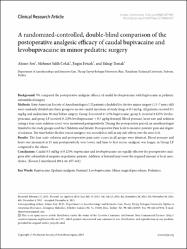A randomized-controlled, double-blind comparison of the postoperative analgesic efficacy of caudal bupivacaine and levobupivacaine in minor pediatric surgery
Künye
Sen, A., Colak, M.S., Erturk, E., Tomak, Y., (2014).A randomized-controlled, double-blind comparison of the postoperative analgesic efficacy of caudal bupivacaine and levobupivacaine in minor pediatric surgery.Korean Journal of Anesthesiology, 66(6), 457-461.https://doi.org/10.4097/kjae.2014.66.6.457Özet
Background: We compared the postoperative analgesic efficacy of caudal levobupivacaine with bupivacaine in pediatric subumbilical surgery. Methods: Sixty American Society of Anesthesiologists I-II patients scheduled for elective minor surgery (1.5-7 years old) were randomly divided into three groups to receive caudal injections of study drugs at 0.5 ml/kg. All patients received 0.1 mg/kg oral midazolam 30 min before surgery. Group B received 0.125% bupivacaine, group L received 0.125% levobupivacaine, and group LF received 0.125% levobupivacaine + 0.5 ?g/kg fentanyl. Blood pressure, heart rate and sedation (using a four-scale sedation score) were monitored perioperatively. During the postoperative period, an anesthesiologist blinded to the study groups used the Children's and Infants' Postoperative Pain Scale to monitor patients' pain and degree of sedation. The time before the first rescue analgesic was recorded as well as any side effects over the next 24 h. Results: The four-scale sedation and postoperative pain scale scores in all groups were identical. Blood pressure and heart rate measured at 15 min postoperatively were lower, and time to first rescue analgesic was longer, in Group LF compared to the others. Conclusions: Caudal 0.5 ml/kg of 0.125% bupivacaine and levobupivacaine are equally effective for postoperative analgesia after subumbilical surgeries in pediatric patients. Addition of fentanyl may lower the required amount of local anesthetics. © the Korean Society of Anesthesiologists, 2014.


















